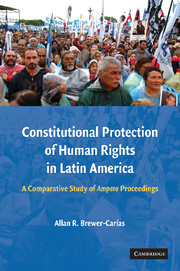 Constitutional Protection of Human Rights in Latin America
Constitutional Protection of Human Rights in Latin America Book contents
- Frontmatter
- Contents
- INTRODUCTION
- PART ONE THE CONSTITUTIONAL AND INTERNATIONAL DECLARATION OF HUMAN RIGHTS AND ITS JUDICIAL GUARANTIES
- PART TWO THE AMPARO AS A LATIN AMERICAN CONSTITUTIONAL AND INTERNATIONAL LAW INSTITUTION
- PART THREE THE INJURED PARTY AND THE CONSTITUTIONAL RIGHTS PROTECTED BY MEANS OF THE AMPARO PROCEEDING
- PART FOUR THE INJURY, THE INJURING PARTY AND THE INJURING ACTS OR OMISSIONS IN THE AMPARO PROCEEDING
- Chapter Twelve The General Conditions of the Injury (Harms and Threats)
- Chapter Thirteen The Reparable Character of the Harms and the Restorative Character of the Amparo Proceeding
- Chapter Fourteen The Imminent Character of the Threats and the Preventive Character of the Amparo Proceeding
- Chapter Fourteen The Injuring Party: The Defendant (Public Entities or Private Individuals)
- Chapter Sixteen The Injuring Public Actions and Omissions of Public Authorities Causing the Harms or the Threats
- PART FIVE THE EXTRAORDINARY CHARACTER OF THE AMPARO PROCEEDING
- CONCLUSION
- APPENDIX A List of Latin American Constitutions
- APPENDIX B List of Latin American Amparo Laws (Statutes)
- INDEX
Chapter Fourteen - The Injuring Party: The Defendant (Public Entities or Private Individuals)
Published online by Cambridge University Press: 08 August 2009
- Frontmatter
- Contents
- INTRODUCTION
- PART ONE THE CONSTITUTIONAL AND INTERNATIONAL DECLARATION OF HUMAN RIGHTS AND ITS JUDICIAL GUARANTIES
- PART TWO THE AMPARO AS A LATIN AMERICAN CONSTITUTIONAL AND INTERNATIONAL LAW INSTITUTION
- PART THREE THE INJURED PARTY AND THE CONSTITUTIONAL RIGHTS PROTECTED BY MEANS OF THE AMPARO PROCEEDING
- PART FOUR THE INJURY, THE INJURING PARTY AND THE INJURING ACTS OR OMISSIONS IN THE AMPARO PROCEEDING
- Chapter Twelve The General Conditions of the Injury (Harms and Threats)
- Chapter Thirteen The Reparable Character of the Harms and the Restorative Character of the Amparo Proceeding
- Chapter Fourteen The Imminent Character of the Threats and the Preventive Character of the Amparo Proceeding
- Chapter Fourteen The Injuring Party: The Defendant (Public Entities or Private Individuals)
- Chapter Sixteen The Injuring Public Actions and Omissions of Public Authorities Causing the Harms or the Threats
- PART FIVE THE EXTRAORDINARY CHARACTER OF THE AMPARO PROCEEDING
- CONCLUSION
- APPENDIX A List of Latin American Constitutions
- APPENDIX B List of Latin American Amparo Laws (Statutes)
- INDEX
Summary
THE INJURING PARTY
Because the amparo procedure is governed by the principle of bilateralism, the party that initiates it, that is the plaintiff, whose constitutional rights and guaranties have been injured or threatened, must always file the action against an injuring party, whose actions or omissions are those that have caused the harm or threats.
This means that the action must always be filed against a person or a public entity that must also be individuated as defendant. That is why in the amparo proceeding, as well as the injunctions in the United States, the final result has to be a judicial order “addressed to some clearly identified individual, not just the general citizenry.”
Thus, since the beginning of the proceeding when the action is filed, or during the procedure, the bilateral character of the amparo suit implies the need to have a procedural relation that must be established between the injured party and the injuring one who must also participate in the process.
The question of the individuation of the defendant
This need for the individuation of the defendant also derives from the subjective or personal character of the amparo in the sense that in the complaint, as it is generally provided in all the Latin American Amparo Laws, the plaintiff must clearly identify the authority, public officer, person or entity against whom the action is filed.
- Type
- Chapter
- Information
- Constitutional Protection of Human Rights in Latin AmericaA Comparative Study of Amparo Proceedings, pp. 289 - 304Publisher: Cambridge University PressPrint publication year: 2008


